EnglishItaliano
Schifanoia. Mese per mese: Aprile-Toro
Schifanoia. Month by month: April-Taurus
Il cielo
The Sky
a cura di Marco Bertozzi
by Marco Bertozzi
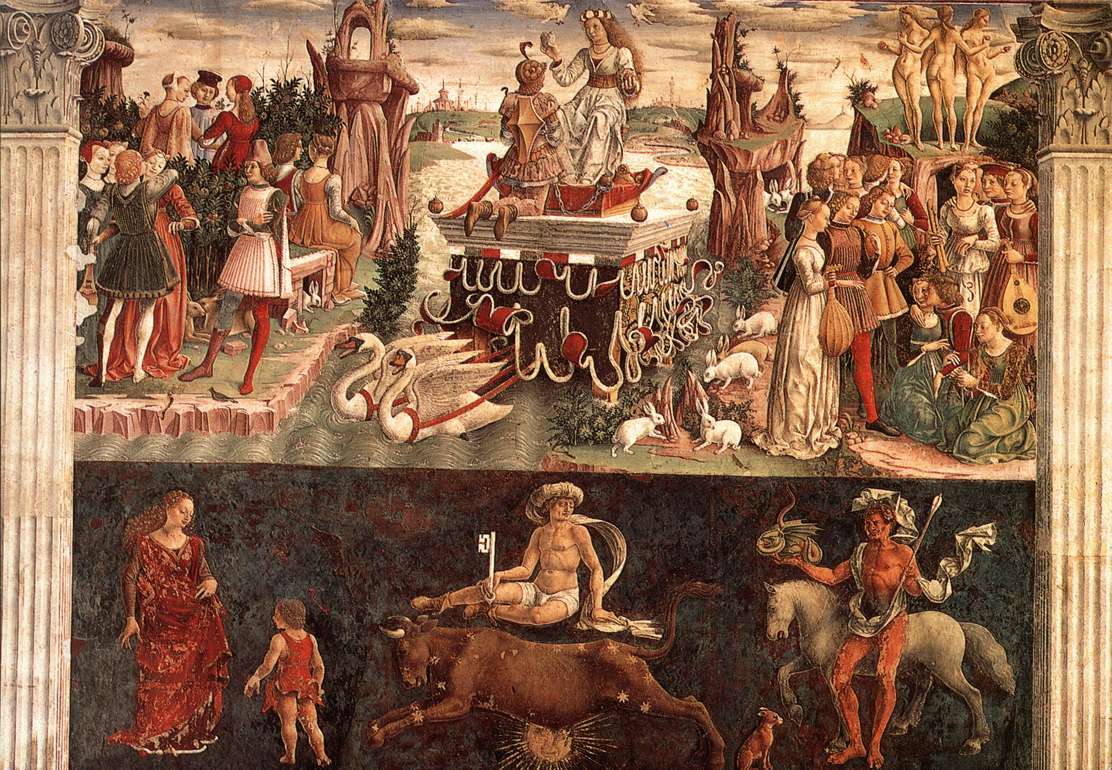
Francesco del Cossa, I registri superiori del mese di Aprile
Francesco del Cossa, the upper registers of the month of April
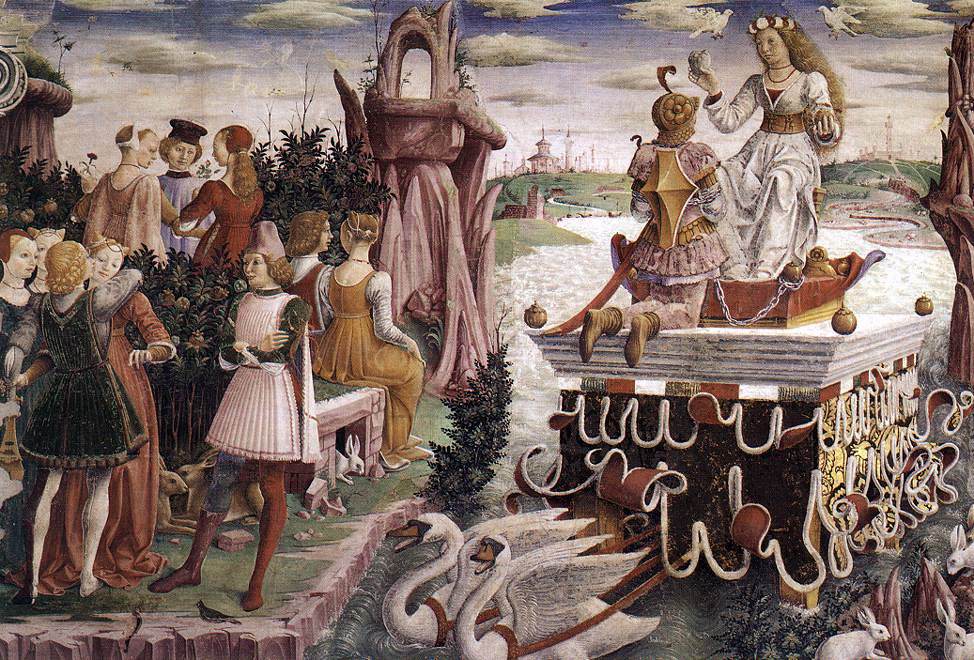
Il carro di Afrodite
The chariot of Aphrodite
Fascia superiore
Upper register
Tutela di Afrodite (Venere). La dea dell’amore celebra il suo trionfo su un veicolo, trainato da bianchi cigni, che discende lungo le acque di un fiume. L’imbarcazione è ornata da tendaggi, mossi da un brioso vento primaverile. Di fronte a Venere è inginocchiato e avvinto, in catene, il bellicoso Marte, alla cui tutela è affidato il segno diametralmente opposto a quello del Toro, cioè lo Scorpione.
I lunghi capelli della dea sono stretti da una colorata ghirlanda e sulla sua cintura è raffigurato il giovane Eros (Cupido) che scaglia le sue frecce verso due innamorati. A destra e a sinistra della scena, due splendidi giardini, dove sbocciano gli amori dei figli della dea: giovani donne e uomini di corte, ritratti dall’artista, con inconsueto realismo, in audaci e sensuali abbracci. Alla sinistra di Venere, l’intensa nudità delle tre Grazie. Ai piedi dei giovani corrono numerosi conigli e grosse lepri, simboli dell’amore, a sottolineare ulteriormente il carattere dell’intera scena.
The sky of April is under the guardianship of Aphrodite (Venus). The goddess of love celebrates her triumph on a vehicle drawn down the waters of a river by two white swans. The vessel is adorned with curtains stirred by a lively spring breeze. Mars with his hands tied up in chains kneels before her. To him is assigned the sign which is the diametrical opposite of Taurus – Scorpio.
The goddess’s long hair is held back by a colourful garland of flowers and a youthful Eros (Cupid) is portrayed on her belt shooting arrows at the two lovers. To the right and left of the scene there are two splendid gardens where the loves of the children of the goddess are blossoming: they are the young men and women of the court depicted by the artist with unusual realism caught in daring, sensuous embraces. To the left of Venus, the three naked Graces preside over the scene where at the feet of the young courtiers numerous rabbits and large hares, symbols of love, run around, further highlighting the nature of the whole scene.
Fascia mediana – I tre decani accompagnati dal segno zodiacale del toro
Central register – three decans accompanied by the Zodiac sign of Taurus

I tre decani con il segno zodiacale del Toro
The three decans with the Zodiac sign of Taurus
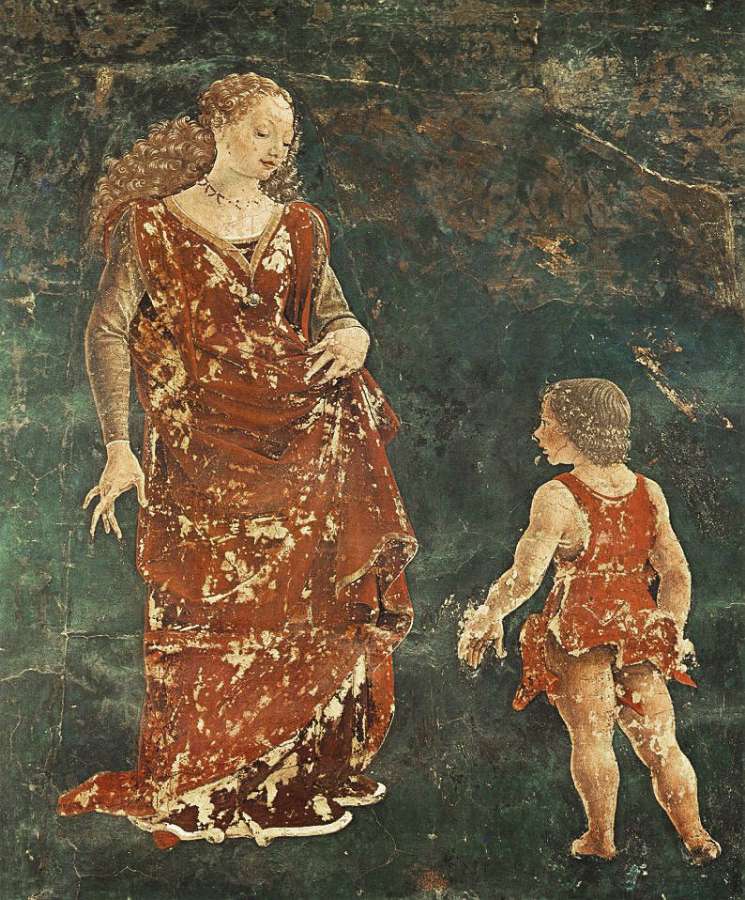
Primo decano del Toro
The first decan of Taurus
Primo decano (Toro I)
First decan (Taurus I)
Una donna, in piedi, dai lunghi capelli biondi e ricci, sciolti sulle spalle e trattenuti da un nastro; indossa un elegante abito rosso, che sembra in parte bruciato, e guarda un bambino (il figlio) che, in piedi davanti a lei, è coperto da un vestito dello stesso colore.
La descrizione dipende dalla sfera indiana di Albumasar (Bertozzi 1999, 47-49; Jaffé [1932] 1999, 115). L’immagine della madre e del figlio risale alla configurazione stellare delle Pleiadi, che si levano in questo decano. Dall’unione con Zeus di Maia, una delle Pleiadi, era nato Hermes (Mercurio). L’attributo del vestito rosso, in parte bruciato, si collega alla perdita di luminosità delle Pleiadi: una delle sette stelle, già ai tempi di Arato (III secolo a.C.), risultava ormai “bruciata”, non più visibile (Arato, Fen., 257; cfr. Bertozzi 1999, 47).
A woman standing, with long blonde, curly hair hanging loosely around her shoulders held back by a ribbon; she is wearing a red dress which seems partly burned, and she gazes at a child (her son) who, standing before her, is wearing a dress of the same colour.
This description comes from the Indian sphere of Albumasar (Bertozzi 1999, 47-49); Jaffé [1932] 1999, 115). The image of mother and son goes back to the stellar configuration of the Pleiades who appear in this decan. From the union of Maia, one of the Pleiades, with Zeus, Hermes (Mercury) was born. The attribute of red dress, partly scorched, is connected with the loss of the brightness of the Pleiades: one of the seven stars was already burned up and no longer visible at the time of Aratus (3rd Century BC), (Aratus, Phaenomena, 257; see Bertozzi 1999, 47).
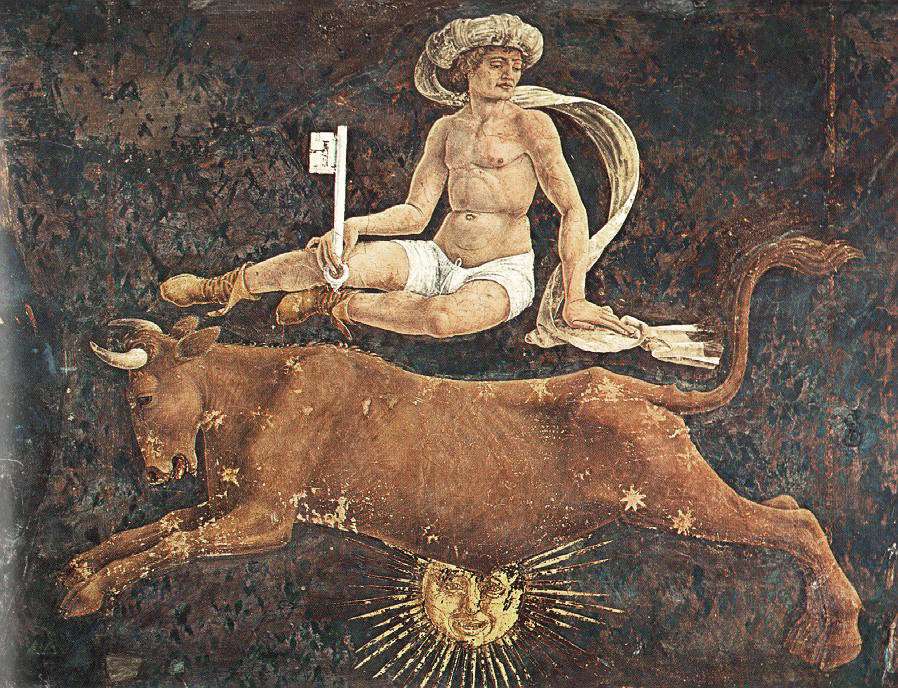
Secondo decano del Toro
Second decan of Taurus
Secondo decano (Toro II)
Second decan (Taurus II)
Un uomo nudo, il capo coperto da una sorta di turbante, porta corti stivali. Esibisce una grande chiave, che tiene con la mano destra.
Analoghe descrizioni si trovano nei compendi di Leopoldo d’Austria e Ludovico de Angulo (Bertozzi 1999, 49; Jaffé [1932] 1999, 115). Nel trattato di Albumasar, si parla di un uomo nudo che tiene una chiave e che ha la testa simile a quella di un cane. Questo attributo ci suggerisce che si tratta di Sirio, la luminosa stella della costellazione del Cane Maggiore. Il Toro, secondo il mito astrale menzionato da Igino (II–III secolo d.C.), era stato posto in cielo per trasportare incolume Europa a Creta, e il Cane aveva ricevuto da Giove la funzione di custode di Europa (Igino, De astr., II, 21, 1; II, 45, 1; cfr. Bertozzi 1999, 49).
A naked man, wearing something resembling a turban on his head, and short ankle boots on his feet. In his right hand he is holding a large key. Similar descriptions can be found in the compendia of Leopold of Austria and Ludovico the Angle (Bertozzi 1999, p.49; Jaffé [1932] 1999, 115).
In Albumasar’s treatise, there is mention of a naked man with a head similar to that of a dog holding a key. This attribute suggests to us that this is Sirius, the bright star in the constellation of Ursa Major. The bull, Taurus, according to the astral myth cited by Hyginus (2-3rd AD), was placed in the heavens to carry Europa to Crete intact, and Jove had assigned to the dog, Canis, the duty of protecting Europa (Hyginus, De astr., II, 21, 1; II, 45, 1; see Bertozzi 1999, 49).
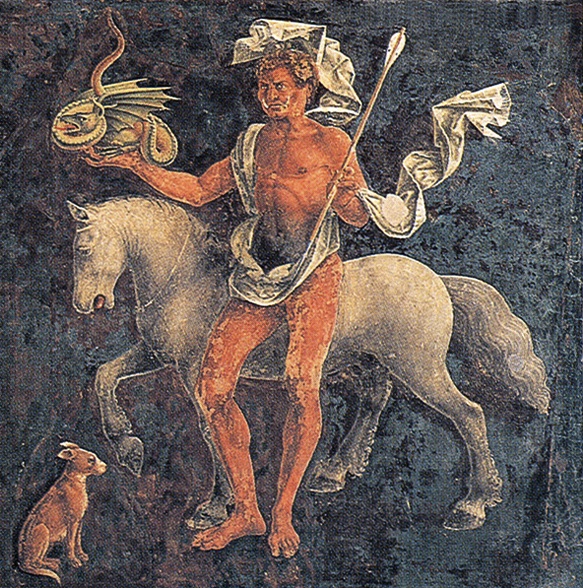
Terzo decano del Toro
Third decan of Taurus
Terzo decano (Toro III)
Third decan (Taurus III)
Un uomo di carnagione scura, nudo, dai canini simili a zanne di cinghiale; tiene nella mano destra un serpente alato e avvolto su se stesso. Ha una freccia nella mano sinistra; alle sue spalle è raffigurato un cavallo e, ai suoi piedi, un cane.
Il cavallo di questo “vir niger” si riferisce a Pegaso, il cavallo boreale. Ma, per il resto, la figura risulta da una complessa mescolanza della sfera indiana e persiana di Albumasar e dal compendio di Leopoldo d’Austria, oltre che dal testo di magia astrologico-talismanica Picatrix (Bertozzi 1999, 47-51; Jaffé [1932] 1999, 115). Punto di riferimento stellare è Aldebaran (nome arabo attribuito allo splendente occhio del Toro), appartenente alle sette stelle che formano le “piovose” Iadi. Il termine Hyades fu tradotto in latino con Suculae (le porcellette), secondo l’interpretazione accolta anche da Manilio (Astr. V, 126 ss.). La traduzione latina risale ad un termine greco che significa “cinghiale”: allusione alle zanne, che costituiscono un peculiare attributo della figura di questo decano (Bertozzi 1999, 50).
A man with dark skin, naked, with canine teeth similar to those of a boar; in his right hand he holds a winged snake encircling itself. In his left hand he has an arrow; behind him there is an image of a horse, and at his feet that of a dog.
The horse of this “Vir niger” is a reference to Pegasus, the horse that could fly as fast as the northern wind, Boreas. However, the rest of this figure is a complex blend of Albumasar’s Indian and Persian spheres, and Leopold of Austria’s compendium, as well as the texts on astrological and talismanic magic by Picatrix (Bertozzi 1999, 47-51; Jaffé [1932] 1999, 115). A point of reference for the stars is Aldebaran (an Arab term that refers to the fiery eye of the Bull), belonging to the seven stars that form the rainy Hyades. The term Hyades was translated into Latin with the term Suculae (the piglets), in accordance with the interpretation also accepted by Manilius (Astr. V, 126 ss.). The Latin translation originates from the Greek term meaning “boar”, alluding to the teeth that are a characteristic feature of the figure for this decan (Bertozzi 1999, 50).
Gli artisti di aprile*
a cura di Giovanni Sassu
Aprile presenta le medesime vicende critiche esposte nella scheda relativa a Marzo.
Qui, come nel mese immediatamente precedente, appare assai forte l’influenza del viaggio a Firenze che, stando a parte della critica, Francesco del Cossa avrebbe intrapreso prima di Schifanoia. Molte delle soluzioni espresse nella parete est appaiono infatti impensabili senza una profonda conoscenza di quanto si poteva ammirare a Firenze negli anni Sessanta (ad esempio, opere come la Natività affrescata da Alesso Baldovinetti nel 1460-62 alla Santissima Annunziata). Tale indirizzo di stile appare però stemperato rispetto ad altre opere di Cossa come la di poco precedente Pala dell’Osservanza di Dresda, forse a causa del contatto con le novità della cultura figurativa ferrarese al rientro in patria dell’artista.
Centrale, in questo senso, è l’esperienza figurativa della cosiddetta “serie E” dei “Tarocchi del Mantegna” – databile poco prima del 1467 – e frutto dell’ideazione del decano degli artisti borsiani, Gherardo di Andrea da Firenze. Le molte assonanze con la parete est di Schifanoia hanno indotto ad attribuire allo stesso Cossa le fortunate serigrafie. Destituita di fondamento, questa ipotesi può però essere corretta ponendo Cossa nel 1469 in scia degli “Pseudo Tarocchi”, come attestano le più volte rilevate riprese sui muri di Schifanoia che gli spettano, ad esempio nei sapienti di Marzo o nei cortigiani di Aprile. Più in profondità, appare desunta dai personaggi disegnati da Gherardo da Vicenza la predilezione per l’articolazione delle mani in pose di un’eleganza sfinita, con il mignolo innaturalmente lontano dal resto delle dita. Tale aspetto compare nella pittura cossesca solo da Schifanoia in poi. Nelle opere precedenti – Pala dell’Osservanza e vetrata del Jacquemart-André, ad esempio – tale stilema appare del tutto sconosciuto.
Cossa accede così a questa idea al rientro a Ferrara dai viaggi fiorentini e bolognesi, prima di mettersi all’opera a Schifanoia (1469), facendola propria a partire da questo momento e trasformandola in una vera cifra stilistica e figurativa.
Il mese di Aprile è senza dubbio la composizione più riuscita dell’intero ciclo. Memorabili infatti risultano molti dei brani del Trionfo, fortunatissima icona di Ferrara e dell’arte estense, il vigoroso decano sulla destra o le figure di popolani del Palio impegnati a correre. La varietà di accenti personali, dalle acconciature alle pose e alle espressioni, confrontate con le altri parti sopravvissute del ciclo, consente di ribadire che, se nella realizzazione della decorazione vi fu un controllo ferreo, esso riguardò esclusivamente la fascia borsiana. Nelle altre due, Prisciani deve essersi limitato a fornire la composizione generale e a indicare gli attributi iconografici delle figure.
Sembra un’idea autonoma di Cossa la straordinaria invenzione del paggio seduto sulla cornice dipinta, con le gambe che invadono il simulato spazio reale, che non trova riscontro nelle altre scene sopravvissute.
Infine, è da ricordare che il varco che oggi collega il Salone alla Sala di Domenico di Paris è quasi del tutto originale. Il milanese Santo Brasca, che visitò Schifanoia nel 1480, testimonia che dal Salone si accedeva ad ovest verso la cappella del Palazzo, e ad est alla Sala degli Stucchi. È credibile che la decorazione continuasse sulla porta, come avveniva per le finestre. Alla fine dell’Ottocento questo dato era ben noto, come prova il rilievo di Mazzolani che illustra proprio questa specificità dell’Aprile (Ferrara, Musei Civici d’Arte Antica, inv. S/163).
*Estratto da Cosmè Tura e Francesco del Cossa. L’arte al tempo di Borso d’Este, cat. della mostra a cura di M. Natale, Ferrara 2007, 434-435.
The artists of April*
by Giovanni Sassu
April displays the same critical aspects expounded in the factsheet relating to March.
Here, as in the month immediately preceding it, the influence of the trip to Florence which, according to the critics, Francesco del Cossa took before arriving at Schifanoia, appears to be very strong. Many of the solutions expressed in the eastern wall are in fact unthinkable without a deep understanding of what could be seen in Florence in the sixties (for example, works such as the frescoed Nativity painted by Alesso Baldovinetti in 1460-62 in the Santissima Annunziata). This style, however, appears toned down compared to other works of Cossa such as the slightly earlier Pala dell’Osservanza of Dresden, and is perhaps due to contact with the novelties of figurative art in Ferrara on the artist’s return home.
Central, in this sense, is the figurative familiarity with the so-called "E-series" of Mantegna’s Tarot cards dated shortly before 1467 – and a result of the decans devised by Borso’s artist, Gherardo di Andrea da Firenze. The many similarities with the eastern wall of Schifanoia have led to the contentious screen-prints being attributed to Cossa. Although groundless, this suggestion can be corrected by placing Cossa in 1469 in the wake of the "Pseudo Tarots", as proved by the often noted resumption of work on the walls of Schifanoia that are attributable to him, for example the Wise Men in March and the courtesans in April. On a deeper level, it would appear that his predilection for the way hands are articulated in poses of extreme elegance, with the little finger unnaturally distant from the rest of the fingers was modelled on characters painted by Gherardo da Vicenza. This aspect appears in Cossa’s works only from Schifanoia onwards. In his previous works – the Pala dell’Osservanza and glass windows of Jacquemart-André, for example - this stylistic feature is completely unknown.
So Cossa accesses this idea on his return to Ferrara after his travels to Florence and Bologna, before starting work at Schifanoia (1469), making it his own as of this moment and turning it into a genuine stylistic and figurative cipher.
The month of April is without doubt the most successful composition of the entire cycle. In fact, many of the fragments of the Triumph, a popular icon of Ferrara and the art of the d’Este, the vigorous decan on the right, and the figures of the common people running in the Palio are unforgettable. The variety of personal accents, from hairstyles to poses and facial expressions, compared with the other surviving parts of the cycle, justify reiterating that, if the realization of the decoration was governed by an iron fist, it was only in the fascia referring to Borso. In the other two, Prisciani must have confined himself to providing the general composition and indicating the iconographic attributes of the figures.
It would seem that the extraordinary invention of the page sitting on the painted frame, with legs invading the simulated real space, which has no parallels in the other surviving scenes, was all Cossa’s.
Finally, it should be remembered that the passage that now connects the Hall of the Months to the Hall of Domenico di Paris is almost completely original. Santo Brasca, from Milan, who visited Schifanoia in 1480, witnesses that from the Hall one could access the western wing by the Palace Chapel, and the eastern wing from the Hall of Stuccoes. It is plausible that the decorations continued over the door, as was the case for the windows. At the end of the nineteenth century this information was well known, as evidenced by the finding of Mazzolani who illustrates this very specific detail of April (Ferrara, Civic Museum of Ancient Art, inv. S/163).
*Estract from Cosmè Tura e Francesco del Cossa. L’arte al tempo di Borso d’Este, cat. of the exhibition curated by M. Natale, Ferrara 2007, 434-435.
> Riferimenti bibliografici
English abstract
Month by month: April-Taurus is a guide to reading the frescoes of the zodiac sign of Taurus in Palazzo Schifanoia and it also reports the artists who painted these works.
keywords | Palazzo Schifanoia; Salone dei Mesi; Frescoes; Zodiac; Taurus.
English abstract
Month by month: April-Taurus is a guide to reading the frescoes of the zodiac sign of Taurus in Palazzo Schifanoia and it also reports the artists who painted these works.
keywords | Palazzo Schifanoia; Salone dei Mesi; Frescoes; Zodiac; Taurus.
Per citare questo articolo / To cite this article: M. Bertozzi, Schifanoia. Mese per mese: Aprile-Toro, “La Rivista di Engramma” n. 105, aprile 2013, pp. 51-55 | PDF
Per citare questo articolo in versione inglese/ To cite this article english version: E. Thomson, Schifanoia. Month by month: April-Taurus, “La Rivista di Engramma” n. 105, aprile 2013, pp. 55-56 | PDF